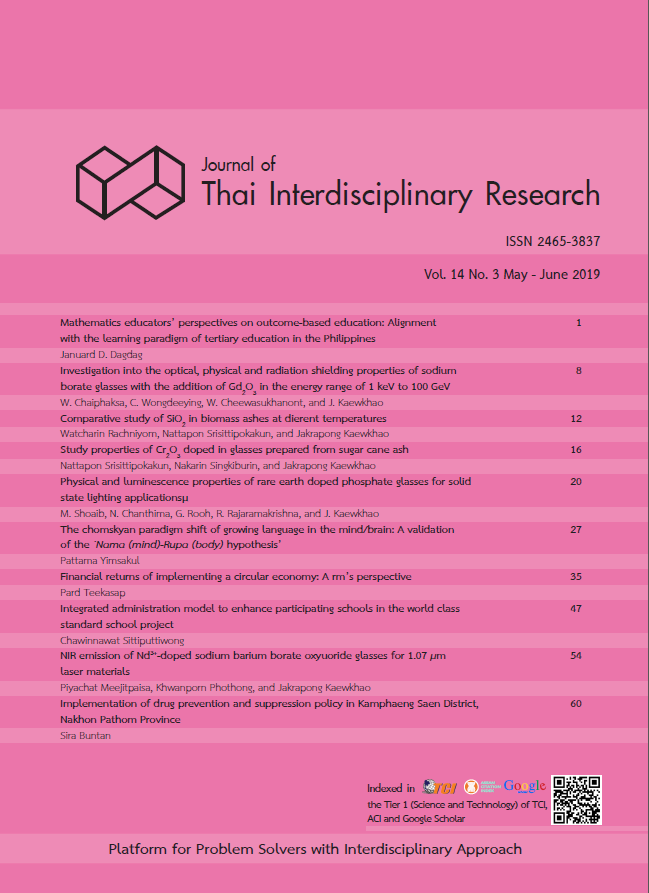Financial returns of implementing a circular economy: A firm’s perspective
Main Article Content
Abstract
Economic growth is considered to be desirable for all countries. However, the limited resources on our planet present a problem with the infinite resource assumption of infinite growth economic models. The circular economy concept seeks to reduces these problems by unbundling resource limitation from economic growth through the reduce, reuse, and recycle approach. This concept has been strongly adopted globally using a top-down approach. An example of this is when the Chinese government enacted a circular economy law. In other countries, however, that are driven by the private sector, the implementation has stagnated due to a perception that firms will have lower return from implementing a circular economy production system. Little research exists to confirm if their perceptions are correct or not. This paper, therefore, aims to fill this gap by studying the financial benefit/cost of implementing a circular economy from a firm’s perspective. A system dynamics method has been used in this study because no public firm was found in Thailand that claimed that they have fully implemented a circular economy concept. The system dynamics approach enables this data limitation to be overcome as this methodology allows us to examine the impact of a circular economy based on a theoretical analysis. In addition, this method shows results using graphs which are easy to understand and analyze. The results of the study show that firms that implement a circular economy concept will have better performance than firms that do not. Firms implementing a circular economy approach will have a higher profit due to an increase in revenue and also lower costs in the long term. Higher revenues come from selling products at a higher price. Even though the price increases have a negative eect on the demand, the eect is minimal and it takes a long period for this eect to happen.
Article Details
References
International Monetary Fund, Seeking sustainable growth: Short-term recovery, Long-term challenges, in World Economic Outlook, International Monetary Fund, Washington, DC (2017).
United Nations DoEaSA, Population Division, World Population Prospects: The 2017 Revision, United Nations, New York, NY (2017).
B. Su, A. Heshmati, Y. Geng, X. Yu, A review of the circular economy in China: moving from rhetoric to implementation, Journal of cleaner production 42 (2013) 215-227.
P. Ghisellini, C. Cialani, S. Ulgiati, A review on circular economy: the expected transition to a balanced interplay of environmental and economic systems, Journal of cleaner production. 114 (2016) 11-32.
Y. Geng, J. Fu, J. Sarkis, B. Xue, Towards a national circular economy indicator system in China: an evaluation and critical analysis, Journal of cleaner production 23 (2012) 216-224.
M. Lieder, A. Rashid, Towards circular economy implementation: a comprehensive review in context of manufacturing industry, Journal of cleaner production 115 (2016) 36-51.
E. Moxnes, Not Only the Tragedy of the Commons : Misperceptions of Feedback and Policies for Sustainable Development, System Dynamics Review 16(4) (2000) 325-348.
M. E. Porter, M. R. Kramer, Creating Shared Value, in Managing Sustainable Business, G. Lenssen, N. Smith, Eds. Dordrecht: Springer (2019).
C. Thongrawd, W. Rittboonchai, Factors affecting coffee consumers, behavior: a case study of consumption in Metropolitan Bangkok, Journal of Thai Interdisciplinary Research 13(5) (2018) 48-53.
N. M. P. Bocken, P. Ritala, P. Huotari, The Circular Economy: Exploring the Introduction of the Concept Among S&P 500 Firms., Journal of Industrial Ecology. 21(3) (2017) 487-490.
K. E. Boulding, The economics of the coming spaceship earth, in Environmental quality issues in a growing economy, Washington, D.C. (1966) 3-14.
R. U. Ayres, A. V. Kneese, Production, Consumption, and Externalities, The American Economic Review 59(3) (1969) 282-297.
R. B. Gordon, M. Bertram, T. E. Graedel, Metal stocks and sustainability, Proceedings of the National Academy of Sciences 103(5) (2006) 1209-1214.
F. Di Maio, P. C. Rem, K. Bald, M. Polder, Measuring resource efficiency and circular economy: A market value approach. Resources, Conservation and Recycling 122 (2017) 163-171.
J. D. Sterman, Business Dynamics : Systems Thinking and Modeling for a Complex World. Boston: Irwin/McGraw-Hill (2000).
J. W. Forrester, Principles of Systems. Waltham, MA: Pegasus Communications Inc. (1999).
J. D. W. Morecroft, Strategic Modelling and Business Dynamics: A Feedback Systems Approach Chichester: Wiley (2007).
J. D. W. Morecroft, Enduring Feedback Structure and Long-term Futures for the Upstream Oil Industry, Systems Research and Behavioral Science 34(4) (2017) 494-509.
G. J. Matthew, W. J. Nuttall, B. Mestel, L. C. Dooley, A dynamic simulation of low-carbon policy influences on endogenous electricity demand in an isolated island system, Energy Policy 109 (2017) 121-131.
D. C. Lane, B. Kopainsky, Natural Resource Management: Contributions of System Dynamics to Research, Policy and Implementation: Selected papers from the Seventh European System Dynamics Workshop, at Bergen University, Norway. Systems Research and Behavioral Science (Special issue) 34 (2017).
D. A. R. George, B. C. Lin, Y. Chen, A circular economy model of economic growth, Environmental modelling & software 73 (2015) 60-63.


